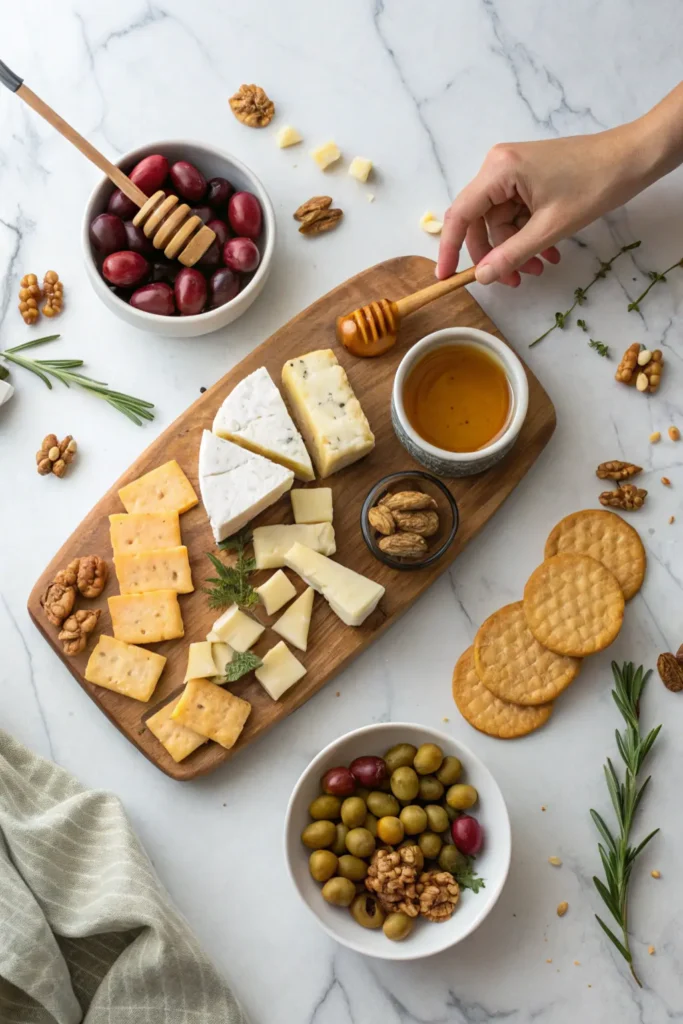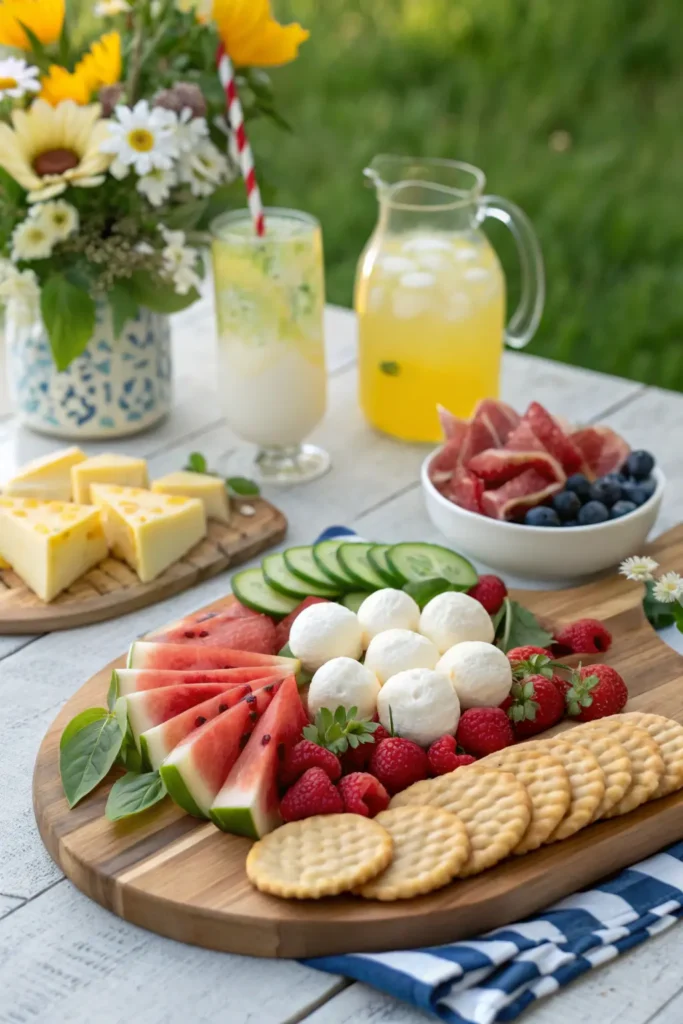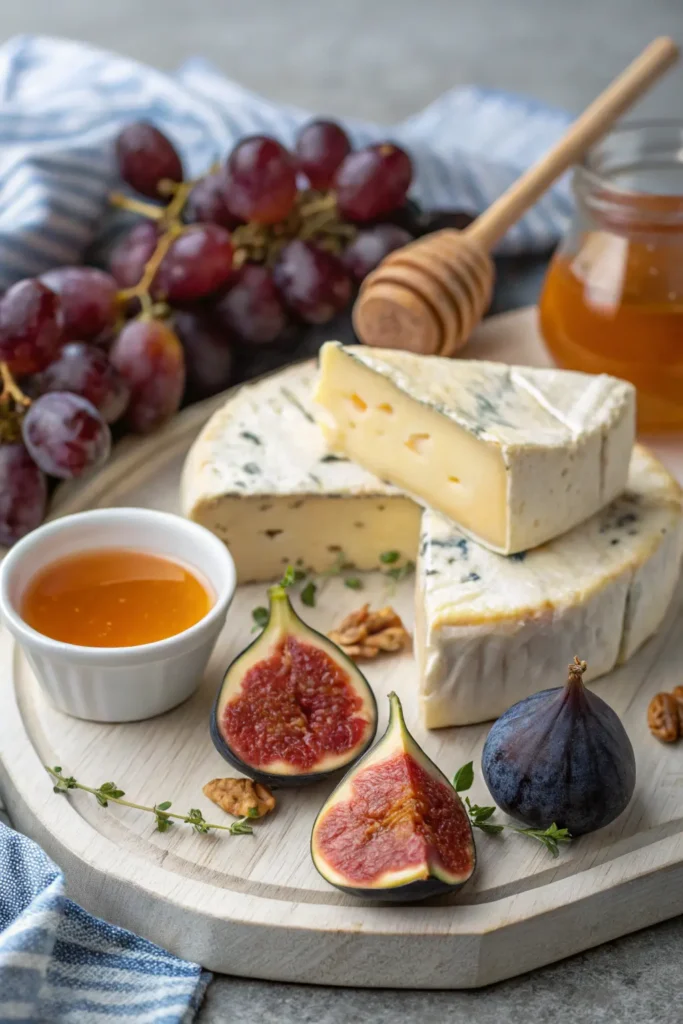If you’ve ever stood in front of a party table and thought, “Wow, that cheese board looks amazing!”—you’re not alone. A cheese board isn’t just a bunch of snacks thrown together; it’s a curated, edible work of art that’s perfect for entertaining, celebrating, or simply indulging at home.
Whether you’re putting together a casual weeknight board for two, a full-blown holiday platter for a crowd, or an elegant grazing board for wine night, this guide will show you how to build the perfect cheese board. We’ll walk through the types of cheese to include, ideal pairings, how to design a board that wows visually, and even cover seasonal themes and beverage pairings.
Plus, we’ll wrap things up with budget-friendly tips, answers to common questions, and expert ideas to make your next cheese board the highlight of the table. Let’s jump into the delicious world of cheese boards!
Discover with us this easy and delicious recipe: Best Keto Zucchini Recipes
What Is a Cheese Board?
The Definition and History of the Cheese Board
A cheese board, also known as a cheese platter or charcuterie board, is a thoughtfully arranged selection of cheese, meats, fruits, crackers, and spreads served on a flat surface—usually wood, slate, or marble. It’s not just a dish; it’s an experience.
Origins of Cheese Boards and Charcuterie Traditions
The concept of serving cheese with accompaniments dates back centuries, particularly in France and Italy where charcuterie (cured meats) and fromage (cheese) were often paired with wine. Over time, this humble pairing evolved into the elaborate grazing boards we know today—full of color, texture, and global inspiration.
Modern Cheese Board Trends and Popularity
Thanks to platforms like Instagram and Pinterest, cheese boards have become the star of modern entertaining. People now build boards with themes—from seasonal harvests to brunch spreads—and use everything from rustic trays to cutting boards as their base. It’s all about mixing flavor, form, and fun.
Why Cheese Boards Are Perfect for Entertaining
Let’s face it—people love options, and cheese boards give them that.
Aesthetic Appeal and Crowd-Pleasing Variety
- They’re visually stunning, packed with vibrant colors and interesting textures.
- You can cater to all tastes—creamy, salty, sweet, crunchy, and even spicy.
- They act as both a conversation piece and an appetizer.
Customizable for Any Event or Season
From a cozy winter gathering to a sunny backyard party, a cheese board can be themed and scaled up or down. Whether you’re celebrating a holiday or throwing together a casual picnic, the board adjusts to suit the vibe.
And that’s what makes a cheese board so special—it’s easy, elegant, and endlessly adaptable. Ready to build one? Up next: let’s talk cheese! 🧀
Discover with us this easy and delicious recipe : recipesfreesh
Choosing the Right Cheeses for Your Cheese Board
When it comes to building a cheese board, the star of the show is, of course, the cheese. While the extras are great, your cheese selection sets the tone for the whole board. To keep things interesting, it’s best to aim for a variety of textures, flavors, and milk types. Let’s break it down.
Types of Cheese to Include
For a well-balanced cheese board, include at least three to five types of cheese. This mix should range from mild to bold, soft to firm.
Soft Cheeses: Brie, Camembert, Goat Cheese
- Brie and Camembert are creamy, crowd-pleasing classics. They’re buttery, mild, and perfect for spreading on crackers or baguette slices.
- Goat cheese (chèvre) adds a tangy, earthy flavor and pairs well with honey or dried fruit.
Hard Cheeses: Aged Cheddar, Manchego, Parmesan
- Aged cheddar brings sharpness and a firm bite.
- Manchego (a Spanish sheep’s milk cheese) is nutty and slightly sweet—great with fig jam.
- Parmesan or aged Pecorino can be chunked into rugged shards for a rustic look.
Blue and Washed Rind Cheeses
- Gorgonzola or Roquefort adds a bold, salty punch.
- Washed rind cheeses like Taleggio have strong aromas and creamy insides, ideal for adventurous guests.
Balancing Flavors and Textures on Your Cheese Board
Creating balance is key. You don’t want all soft cheeses or all strong flavors.
Pairing Mild and Bold Cheeses for Contrast
- Try combining a mild cheese like mozzarella with something strong like blue cheese.
- Mix creamy with crumbly, and sweet with salty. It keeps guests curious and coming back for more.
Tips on Quantities and Serving Sizes
- Plan on about 2–3 ounces of cheese per person if it’s an appetizer.
- If it’s the main course, bump that up to 5–6 ounces per person.
- Always serve cheeses at room temperature for the best flavor and texture.
With the right cheese combo, your cheese board will offer something for everyone—from the cheese newbie to the aficionado.
Pairing Meats, Fruits, and Extras with Your Cheese Board

Now that your cheese board has a solid cheese lineup, it’s time to fill in the blanks with meats, fruits, nuts, and spreads. These extras don’t just look great—they round out the flavors and elevate the entire eating experience.
Meats to Complement Cheese
Meats are a natural match for cheese, especially on a charcuterie board.
Prosciutto, Salami, and Soppressata
- Prosciutto is thin, salty, and buttery—ideal with soft cheeses and melon.
- Salami adds spice and texture, making it a great contrast to milder cheeses.
- Soppressata, with its bold flavor and chewy bite, pairs well with aged cheddar or gouda.
For a visually stunning presentation, try folding or rolling your meats into small rosettes or ribbons.
Vegetarian Protein Alternatives
Not into meat? No problem.
- Use roasted chickpeas, spiced nuts, or marinated tofu cubes as plant-based alternatives.
- These options still bring texture and savory notes to your cheese board.
Fruits, Nuts, and Spreads for Flavor and Texture
This is where the magic happens—these ingredients balance the richness of cheese with sweet, tart, and crunchy elements.
Fresh vs. Dried Fruits – When and How to Use Them
- Fresh fruits like grapes, strawberries, or apple slices add brightness and color.
- Dried fruits like apricots, figs, or dates bring sweetness and chewiness, perfect with blue or goat cheese.
- Pro tip: Fan out apple slices and fill small bowls with berries for visual appeal.
Jams, Honey, and Mustards to Elevate the Cheese Board
- Fig jam is a go-to—it pairs with almost every cheese, especially brie.
- Honey works wonders on goat cheese or blue cheese.
- Whole grain mustard offers a tangy kick, perfect with sharp cheddar.
Choosing the Right Crackers, Bread, and Vehicles for Your Cheese Board
While cheese is the star, every cheese board needs solid support players—and that’s where bread and crackers come in. These “vehicles” help carry the flavors, add crunch or softness, and keep things clean (no messy fingers here).
Best Bread and Cracker Options for Cheese Boards
Choosing the right base for your cheese is just as important as the cheese itself. You want a neutral flavor that lets the cheese shine, but also enough texture to contrast soft spreads.
Artisan Crackers, Crostini, and Baguette Slices
- Artisan crackers come in all shapes and flavors—multigrain, rosemary, or sea salt are all safe bets.
- Crostini (thin slices of toasted baguette) offer a crunchy, rustic touch that holds up well under soft cheeses.
- Fresh baguette slices are perfect for a classic European-style cheese board and work with any spreadable cheese.
It’s smart to offer a mix of soft and crunchy options so guests can choose their favorite.
Gluten-Free and Low-Carb Alternatives
For dietary needs or variety, include some non-traditional options that still add interest and texture.
Seed Crackers and Veggie Slices
- Seed crackers (made from flax, chia, or sesame) are crunchy, flavorful, and gluten-free.
- Cucumber or bell pepper slices act as low-carb vehicles and bring a refreshing bite to heavier cheeses.
- Rice crackers or nut thins are also great for texture and variety.
By offering several choices, your cheese board becomes more inclusive and enjoyable for every guest—no matter their diet.
Building a Visually Stunning Cheese Board
Of course, we want our cheese board to taste amazing—but let’s not forget, we eat with our eyes first. A board that’s arranged with purpose looks more appetizing and gives off that “wow” factor at any gathering.
Layout Tips and Design Principles
Arranging a cheese board is a little like creating art—only way more delicious. Start by placing your main items first, then build out from there.
Arranging by Texture, Color, and Height
- Cheeses first: Place the cheeses evenly across the board to anchor your layout.
- Height matters: Stack crackers, fold meats, or pile grapes to add dimension.
- Color contrast: Position vibrant fruits near pale cheeses or meats to help each ingredient pop.
Don’t forget to leave space for cutting and grabbing—nobody wants to dig through a cluttered pile of food.
How to Avoid a Cluttered or Unbalanced Look
- Use small bowls for dips, olives, or spreads to define boundaries.
- Stick to odd numbers—three or five types of cheese often look better than four.
- Mirror elements on opposite sides of the board for balance.
Choosing a Cheese Board Platter or Surface
The base sets the tone, so don’t overlook your serving surface.
Wood, Slate, Marble, and Alternatives
- Wood boards give off a warm, rustic feel and work for any theme.
- Slate adds contrast and lets you label cheeses with chalk—perfect for parties.
- Marble feels upscale and stays cool longer, which helps with soft cheeses.
- Ceramic trays or cutting boards also do the job if you’re building on a budget.
With the right layout and surface, your cheese board will not only taste amazing—but look like it belongs in a magazine. Up next, we’ll explore fun themes and seasonal variations to keep your boards fresh year-round.
Cheese Board Themes and Seasonal Variations

One of the best things about a cheese board is how flexible it is. You can create one for any occasion, match it to a season or holiday, or give it a fun, creative theme. Whether you’re planning a festive celebration or a cozy night in, customizing your cheese board adds a personal touch that guests will love.
Themed Cheese Boards for Holidays and Events
From spooky spreads to elegant holiday trays, themed boards make a bold statement—and they’re surprisingly easy to pull together.
Christmas, Halloween, and Summer Gatherings
- Christmas cheese board: Add red and green fruits (like strawberries and grapes), rosemary sprigs for a “wreath” effect, and a variety of soft and hard cheeses.
- Halloween board: Use orange cheeses like cheddar, add black grapes or olives, and cut cheeses into spooky shapes with cookie cutters.
- Summer picnic board: Keep it light with goat cheese, mozzarella balls, fresh berries, and prosciutto—serve with chilled white wine or sparkling water.
Themed cheese boards don’t just look festive—they create a fun and memorable experience for your guests.
Seasonal Cheese and Produce Pairings
Let the seasons guide your ingredients. You’ll get the freshest flavors and keep things exciting all year long.
Winter Cheeses vs. Summer Cheeses
- Winter: Opt for rich, bold cheeses like blue cheese, aged cheddar, or Gruyère. Pair with dried fruits, figs, and hearty breads.
- Summer: Go lighter with brie, burrata, and chèvre. Add fresh peaches, tomatoes, cucumbers, and honey for a fresh, sunny bite.
DIY Cheese Board Tips for Beginners

Feeling a little intimidated by all the cheese board inspiration out there? Don’t worry—building a beautiful and tasty board is easier than it looks. Whether you’re hosting for the first time or putting together a last-minute snack tray, these beginner-friendly tips will help you nail it.
How to Shop for a Cheese Board on a Budget
You don’t have to spend a fortune to make a cheese board look gourmet. With a few clever choices, you can build an elegant spread without blowing your budget.
Affordable Cheeses That Still Impress
- Stick with quality over quantity—choose 2 to 3 flavorful cheeses instead of 5 or 6 basic ones.
- Budget-friendly crowd-pleasers include sharp cheddar, herbed goat cheese, and wedge-style gouda.
- Check your local deli or supermarket for cheese ends or sampler packs—perfect for smaller boards.
Also, balance pricey items with low-cost add-ons like crackers, fruits, and nuts to bulk up the board without stretching your wallet.
Quick Assembly Tips for Last-Minute Cheese Boards
Running short on time? You can still put together a great-looking cheese board in minutes with these time-saving tricks.
Pre-Cut Ingredients and Layout Shortcuts
- Use pre-sliced cheeses and deli meats to skip cutting altogether.
- Grab a pre-mixed container of nuts or dried fruits for variety without extra prep.
- Place a few ingredients in small bowls to create structure fast—jams, olives, or honey work great.
- Fill empty spaces with grapes or crackers to finish it off quickly.
With just a few shortcuts, your last-minute board can still look planned and polished.
Frequently Asked Questions (FAQs)
When it comes to crafting the perfect cheese board, even seasoned hosts have questions. So, let’s dig into some of the most common ones asked by cheese lovers, party planners, and charcuterie fans alike.
How Much Cheese Do I Need Per Person?
This depends on whether your cheese board is a starter or the main event:
- For appetizers, plan about 2–3 ounces of cheese per person.
- For a full meal or grazing board, go for 5–6 ounces per guest.
- Always round up slightly if your crowd loves cheese—leftovers are never a bad thing!
How Far in Advance Can You Assemble a Cheese Board?
You can prep ahead to save time, but timing matters:
- Hard cheeses can be sliced or cubed up to a day in advance and stored in an airtight container.
- Soft cheeses should be placed on the board about 30 minutes before serving to soften and bring out their flavor.
- Assemble the full board 1–2 hours before guests arrive, cover loosely, and refrigerate. Bring it to room temp before serving.
What Is the Best Cheese for a Cheese Board?
There’s no single “best” cheese—it’s all about variety! But here are some top picks:
- Brie or Camembert for soft lovers.
- Aged cheddar or gouda for something sharp and nutty.
- Goat cheese for a tangy twist.
- Blue cheese for bold flavor.
Mixing these gives you a well-rounded cheese board.
How Do You Keep Cheese Fresh on the Board?
- Keep cheeses out of direct sunlight or heat.
- Serve over marble or stone platters to help keep things cool.
- If your board will sit out for a while, place it over a chilled tray or ice pack wrapped in cloth.
Can a Cheese Board Be Served as a Main Course?
Absolutely! Just add more protein-rich options like meats, nuts, and even boiled eggs or hummus.
- Pair with hearty bread, and you’ve got a full, balanced meal.
A well-designed cheese board can go way beyond just being a starter.
Conclusion
Why Cheese Boards Are More Than Just a Trend
A well-crafted cheese board is more than just a pretty plate—it’s a shared experience. From cozy dinners to festive celebrations, it brings people together in a fun, relaxed way. Not to mention, it’s versatile, seasonal, and endlessly customizable. You can go simple with a few cheeses and crackers or turn it into a full-blown grazing board with meats, fruits, spreads, and drinks to match.
Final Thoughts on Creating Your Own Cheese Board
With all the tips we’ve covered—from choosing the right cheeses to styling your platter—you now have the tools to build a cheese board that’s as stunning as it is delicious. Start with your favorite cheeses, add a mix of textures and flavors, throw in a few personal touches, and serve with confidence.
Whether you’re making a budget-friendly board for two or hosting a crowd, the beauty of a cheese board lies in its flexibility. So go ahead, grab that board, get creative, and let the cheese do the talking.

